7 of the longest-flowering perennials – these varieties will add color to your garden for months🌱
Make sure your planting delivers by choosing the longest-flowering perennials, guaranteeing floral color for the longest possible time
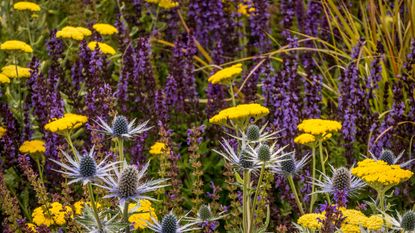
Jump to category:
A well-designed garden offers planting interest from early spring through to late fall. Choose the right perennial plant species and varieties and you will fill your garden with gorgeous blooms for a constant show from early to late in the season.
Perennial plants come back year after year, in most cases multiplying into sizable clumps that you can simply divide in fall. This means you can then spread the plants around your yard to create that fully planted look that’s so desirable.
Fortunately, there are plenty of reliable choices that perform consistently well. The joy of the best perennials is that they are not demanding plus keep on giving and many will tolerate different conditions and US hardiness zones. Here, I reveal what the experts have nominated as their favorite longest-flowering perennials.

Coneflowers are the long-flowering stars of this perennial border
7 longest-flowering perennials to plant in your garden
Grow these easy garden plants and they’ll brighten your space for months every year. The good news is they’re all good plants for pollinators too, so you can help increase the biodiversity of your outdoor space.
1. Salvia
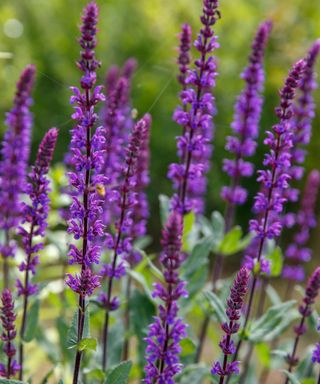
Salvia nemorosa ‘Caradonna’
Perennial varieties of salvia have long-lasting blooms that flower all summer long in US hardiness zone 4 to 10. The key thing to remember when growing salvias is to give them a position in full sun with well-drained soil and deadhead regularly, then you will be rewarded with many more blooms over a longer period of time.
‘Salvia is a huge genus that contains a plethora of good garden plants,’ says flower expert Jenny Rose Carey. ‘They have upright spikes of tubular flowers in blue, red, purple, and pink. There are many different salvias that bloom from spring to fall.’
What are some of the best cultivars? ‘Classic Salvia × sylvestris ‘May Night’ and Salvia nemorosa ‘Caradonna’ are stalwart late-spring perennials in many areas,’ says Jenny Rose. ‘Meanwhile Salvia farinacea ‘Victoria Blue’ blooms strongly from early summer through to fall.’
2. Yarrow
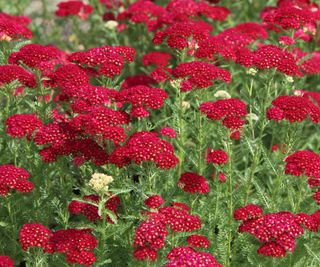
Achillea millefolium (yarrow)
If you’re looking for an easy and reliable plant that flowers from June through to September, likes full sun and heat, and is resilient in tricky locations then yarrow (also known as achillea) is the perfect choice.
Considered one of the best plants for poor soil, these flat-topped flowers will grow almost anywhere and add an interesting dimension to planting design. What’s more, they are pollinator magnets as their flower shape forms the perfect landing pad.
Yarrow is a great choice for repeat planting in flowerbeds and comes in a range of shades including brilliant yellow, soft rose pink and ruby red. This ornamental perennial is native to North America too, and best suited for hardiness zones 3 to 9.
Deadheading spent flowers will lengthen the bloom period, and cutting it back thoroughly in late summer will encourage fresh foliage and blooms to keep the flowering season going.
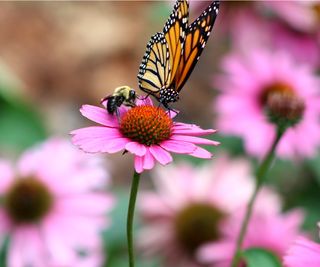
Long-lasting coneflowers are synonymous with late summer. As well as being one of the longest-flowering perennials they are also one of the best flowers for pollinators. They have dusky purple flowers (they’re also known as Echinacea purpurea) with a distinctive orange cone at the center. If you grow them in rich, well-drained soil in full sun you will get a colorful and long-lasting display.
Here’s a top growing tip from Justin Hancock, horticulturist at Costa Farms, expert perennial growers based in Florida and the Carolinas: ‘Early fall is the ideal time to plant most perennials. This allows them to get well rooted before winter so they have a much stronger start in spring. Planting perennial varieties like coneflower in fall will result in more blooms next year than if you wait to plant them in spring.’

Justin Hancock
Justin Hancock is a Costa Farms horticulturist with more than 25 years in the industry. A plant enthusiast and educator, he has a degree in horticultural science and has worked in garden centers and botanical gardens, and as a garden designer. He has experienced gardening across the country, from Minnesota to Miami to Oregon. Hancock is also co-host of the Costa Farms podcast Plant Rx.
4. Black-eyed Susan
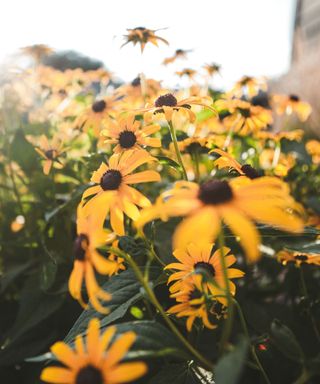
This is another one of the longest-flowering perennials that bloom all summer and require very little care. Deadheading will prompt frequent reblooming and prevent the plants from spreading too prolifically through self-seeding.
‘This native flower is durable, heat tolerant, and flowers all summer long,’ says horticulturalist Gail Pabst of the National Garden Bureau. ‘It’s one of the most popular perennials in North America. Plus, they’re one of the best flowers for bees, butterflies, and other beneficial garden insects, helping to keep aphids, thrips, and whiteflies at bay.’
Black-eyed Susan blooms from June through September in US hardiness zones 3 to 9, on plants that grow 2 to 3 feet in height. The most popular variety is ‘Goldsturm’, while ‘American Gold Rush’ is a new variety. ‘It has bright, golden-yellow flowers with black centers and arched petals.’
Gail Pabst
Gail is a passionate horticulturist with over 25 years’ experience in the industry. She is an avid home gardener too and loves to try out the newest varieties and techniques. Gail’s work with the National Garden Bureau and the All-America Selection has helped her to continue their mission of inspiring and teaching gardening with others.
5. Catmint
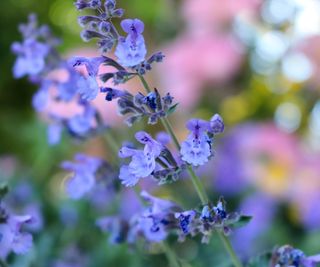
A valued landscaping plant, catmint (also known as Nepeta) blooms from spring through early fall, making it one of the longest-flowering perennials. Chopping down the flower spikes when they’ve faded stimulates vigorous reblooming too.
‘Cut back the plant after the first flowery flush for a new set of blooms later in the season,’ says Jenny Rose Carey. ‘There are several different species of catmint and many cultivars. My favorites are Nepeta racemosa ‘Walker’s Low’ and the hybrid Nepeta × faassenii ‘Cat’s Meow’.
Well-loved by pollinators, this aromatic beauty produces clouds of lavender-blue flowers and delicate silvery foliage that look wonderful as part of your planting design. Catmint is easy to grow in US hardiness zones 3 to 8, and thrives in either full sun or partial shade. It’s not fussy and will even grow in poor soil.
6. Aster
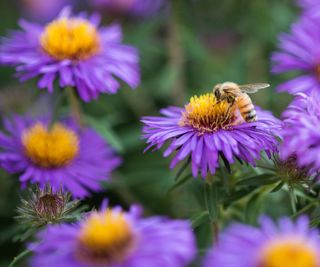
Blooming from summer into late fall, daisy-like asters are stars of the late-season garden. These easy-to-grow flowerbed beauties come in predominantly mauve, purple and pink shades. Also known as Michaelmas daisies, they thrive in US hardiness zones 4 to 8, and are a safe bet if you’re looking for the longest-flowering perennials to fill your garden.
When asters explode into color, bees and butterflies from far and wide descend on them to gather late-season nectar. This means they’re a great choice if you’re looking at extending the pollinator party in your yard right to the end of the year.
They add a starry detail to the front of flowerbeds too, and will grace containers in patios and porches for a low-maintenance planting option. Find more inspiration with the best perennial plants for pots if you’re a balcony gardener.
Plant some asters and they will lift your late-season garden when many other flowers are fading, plus they are fast-growing and will quickly become established to bring delight year after year. Aster plants are available from Walmart.
7. Geum
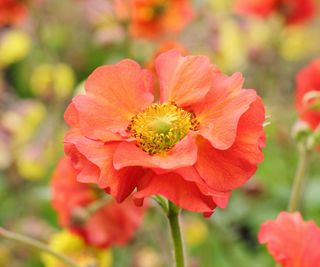
Geum ‘Scarlett Tempest’
With open flowers sitting in airy clusters on long, delicate stems geum are among the prettiest of the longest-flowering perennials. There are many bold orange-colored ones to choose from that will add a vibrant note to your backyard planting design, and you can also get yellow and red varieties.
‘Geum is a recent infatuation,’ says flower expert Jac Semmler. ‘I’m at the stage where I feel like I can’t get enough and want to squeeze more into my garden. Varieties of geum vary in how long they will flower but it is really about timing. Geum plants start to flower in an ideal window, heralding the start of spring. They bloom early and can flower for a long season.’
Regularly deadhead any spent flowers and geum will continue to shine for months stretching right into fall. They will flower more profusely if planted in full sun, and thrive in US hardiness zones 5 to 10. Another plus is that most of the foliage remains green throughout winter, with new leaves emerging in spring.

Jac Semmler
Jac Semmler is foremost an experimental gardener and plant lover. She tends to Super Bloom, a creative plant practice that brings dynamic living beauty and diversity to urban spaces, landscapes and creative projects. Jac is a qualified educator, respected horticulturalist and botanical guide, and often shares her ideas at festivals as well as on radio and podcasts. She is the author of Super Bloom: A Field Guide to Flowers for Every Gardener.
FAQs
What is the longest-blooming perennial?
Our go-to choice when it comes to the longest-blooming perennials is tickseed (Coreopsis). It produces masses of yellow daisy-like flowers and is a native flower that blooms from summer through fall.
Tickseed is an easy-care plant that looks great in flowerbeds, seasonal containers, and prairie planting in US hardiness zones 4 to 9. Tough and durable, coreopsis grow in any soil, sun or partial shade, and are hardy in low temperatures.
Choose a perennial variety of tickseed (there are annual varieties too). For blooms that form in early summer and last until the end of fall, try ‘Moonbeam’ or ‘Early Sunrise’. These will consistently give you some of the best blooms over a long period.
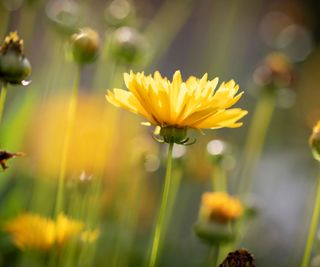
‘Early Sunrise’ coreopsis
Now you can see how important perennials are in your planting scheme you’ll be glad to know there are perennial options for difficult areas of the garden too.
If your garden is shady find out the best choices for part-shade perennials as well as full-shade perennials to deal with these tricky areas. Alternatively, check the best drought-tolerant flowering perennials if a dry garden is the issue.
